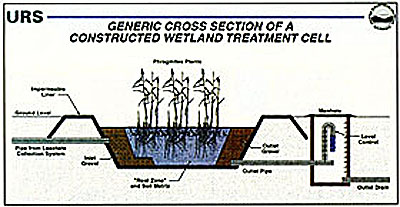Constructed Wetlands Offer Flexibilityby Charles E. Dusel, Jr. and Craig W. Pawlewski |
 Constructed wetlands technology is emerging as a low-cost, easily operated, efficient alternative to conventional treatment systems. Specifically designed for wastewater treatment, constructed wetlands allow for a high degree of flexibility in design. They are not subject to the (jurisdictional wetland) laws and regulations that govern natural wetlands. A constructed wetlands treatment system (CWTS) is a bed composed of the substrate, water-tolerant plants, the water column, and a microbial population. The substrate can be sand, gravel, or soil in which wetland plants are growing. Various plant species can be used in a constructed wetland system. However, naturally occurring plants, such as the common reed, will most likely adapt to the local climate and soil conditions and provide successful treatment. The plants supply oxygen and other nutrients that promote microbial growth in the substrate. It is the microbial population that is largely responsible for treatment in the constructed wetland. Two Types of CWTSs In general, there are two types of CWTSs. The first, the free water surface (FWS) is a shallow bed or channel with aquatic vegetation. The contaminated water to be treated in this system is exposed to the atmosphere. The second type is a subsurface flow (SF) wetland in which the water to be treated is not exposed to the atmosphere. An SF wetland is a bed of permeable media that supports the root system of vegetation. The water level is maintained below the top of the treatment media (subsurface). A complex matrix of distinct aerobic and anaerobic treatment zones becomes established, which improves wastewater treatment. While there is no general consensus regarding the design of the CWTSs, a comparison of the two types is instructive:
Root Zone Method A wastewater treatment technique often used with an SF wetland is the root zone method (RZM). The root zone method uses soil as the medium for the filtration and treatment of impurities found in wastewater. Using soil as a growth medium offers advantages over gravel or sand. First, since soil has a much greater surface area than an equivalent volume of sand or gravel, it can support larger colonies of micro-organisms, resulting in a more efficient treatment system. Secondly, the soil that is selected contains actively charged clay minerals and organic substances (humus materials). These substances can adsorb impurities such as heavy metals, phosphates, and nitrates. Reeds planted in soil create and maintain the conditions for a complex community of microorganisms. Aerobic and anaerobic microbes are found in the ecosystem established within a root zone soil matrix. There are approximately 10,000 different microbial species within root zone soils, many of them found only under such unique conditions. The RZM and the subsurface flow system are used more widely in Europe than in the United States. In particular, Denmark, West Germany, Austria, and Switzerland use it frequently to treat screened raw sewage or primary effluent. In North America and the United Kingdom, gravel- or rock-filled trenches or beds are used for the treatment of primary or secondary effluent. When appropriate, however, the SF wetland is the technology of choice. It is being used currently in the design of a CWTS for the Fort Edward Landfill, a 28-acre Superfund site near Albany, NY, which is being managed by the New York State Department of Environmental Conservation. L&W For more information, contact Charles E. Dusel, Jr., Project Manager, and Craig W. Pawlewski, Chemical Engineer, URS Greiner, Inc., Buffalo, NY, (716)856-5636. |
©2000, 1999, 1998 Land and Water, Inc.